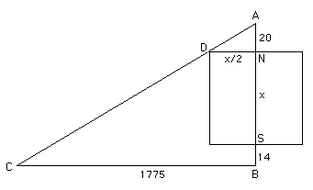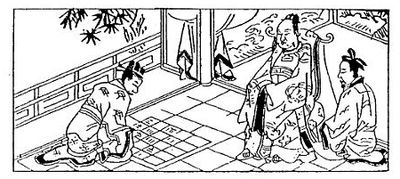Problem[]
| 今有邑方不知大小,各中開門。出北門二十步有木。出南門十四步,折而西行一千七百七十五步見木。問:邑方幾何?
|
Suppose there is a square city of unknown size with a gate in the middle of each side. Walking from the north gate 20 bu, there is a tree. Walking from the south gate 14 bu, turning west and walking 1775 bu, the tree will just come into view. What is the width of the city?
Answer: 250 bu.
|
Solution[]

Figure 1. Diagram of the problem
Quadratic Formula Solution
Let be the width of the town. By proportion,
Cross-multiplication and a bit of rearrangement yields the quadratic equation
Use the quadratic equation to solve for .
Since the negative root makes no sense for our problem, the width of the
square town is 250 bu.
Completing the Square Solution
The ingenious method of the kai fang shu (square root algorithm) was later extended to solve quadratic equations of the form , where is the unknown quantity and are constants. The coefficient of the linear term is called the cong fa (從法), and the Jiuzhang Suanshu does not explicitly explain how the cong fa is incorporated in the square root algorithm. One plausible solution method would be to first implement the well-known technique called "completing the square". By completing the square, one can transform the above quadratic equation into a simpler square root problem. For example, the equation becomes after a change of variable and transformed constant .
After making the transformation , the above quadratic equation becomes
Extracting the positive square root gives , which means the final answer is . Therefore, the width of the square town is 250 bu.
Horner's Method Solution
The Han dynasty arithmeticians likely solved quadratic equations using the Horner-Ruffini method (nearly two millennia before its discovery in the West). By the Song dynasty (960 - 1279 AD), Chinese mathematicians extended this algorithm to solve polynomial equations up to the tenth degree. Here we express the process algebraically instead of the regular Chinese layout on a counting board.
To solve the above quadratic equation using the Horner-Ruffini method, write it like this
Iteration 1
For the first iteration, the quadratic term should be the dominant term. So search for perfect squares such that .
Notice . Let . Then make the transformation.:
Iteration 2
For the second iteration, the linear term should be the dominant term. So search for values of such that .
Notice . Let . Then make the transformation.
Now this is easy to solve by factoring.
Thus or . Since and , it follows that . Therefore, or .
You might be wondering why bother going through such a labourious process to solve such a simple quadratic equation? Bear in mind that without the electronic calculator, solving square roots and quadratic equation is quite challenging. So during the Han dynasty, this method would be computationally more efficient than the quadratic formula!


































